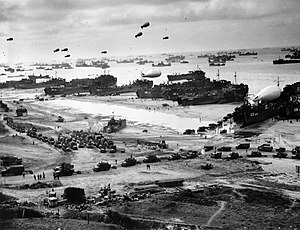Battle of Normandy
| Operation Overlord | |||||||
|---|---|---|---|---|---|---|---|
| Part of the Western Front of World War II | |||||||
 Tank landing ships, with barrage balloons afloat, unloading supplies on Omaha for the break-out from Normandy. |
|||||||
|
|||||||
| Belligerents | |||||||
|
|
|||||||
| Commanders and leaders | |||||||
|
|||||||
| Strength | |||||||
|
|
||||||
| Casualties and losses | |||||||
|
|
||||||
|
Civilian deaths:
|
|||||||
Civilian deaths:
Operation Overlord was the code name for the Battle of Normandy, the Allied operation that launched the successful invasion of German-occupied Western Europe during World War II. The operation was launched on 6 June 1944 with the Normandy landings (Operation Neptune, commonly known as D-Day). A 1,200-plane airborne assault preceded an amphibious assault involving more than 5,000 vessels. Nearly 160,000 troops crossed the English Channel on 6 June, and more than two million Allied troops were in France by the end of August.
The decision to undertake a cross-channel invasion in 1944 was taken at the Trident Conference in Washington in May 1943. General Dwight D. Eisenhower was appointed commander of Supreme Headquarters Allied Expeditionary Force (SHAEF), and General Bernard Montgomery was named as commander of the 21st Army Group, which comprised all the land forces involved in the invasion. The coast of Normandy was chosen as the site of the invasion, with the Americans assigned to land at sectors codenamed Utah and Omaha, the British at Sword and Gold, and the Canadians at Juno. To meet the conditions expected on the Normandy beachhead, special technology was developed, including two artificial ports called Mulberry harbours and an array of specialised tanks nicknamed Hobart's Funnies. In the months leading up to the invasion, the Allies conducted a substantial military deception, Operation Bodyguard, using both electronic and visual misinformation. This misled the Germans as to the date and location of the main Allied landings. Adolf Hitler placed German Field Marshal Erwin Rommel in charge of developing fortifications all along the Atlantic Wall in anticipation of an invasion.
...
Wikipedia
